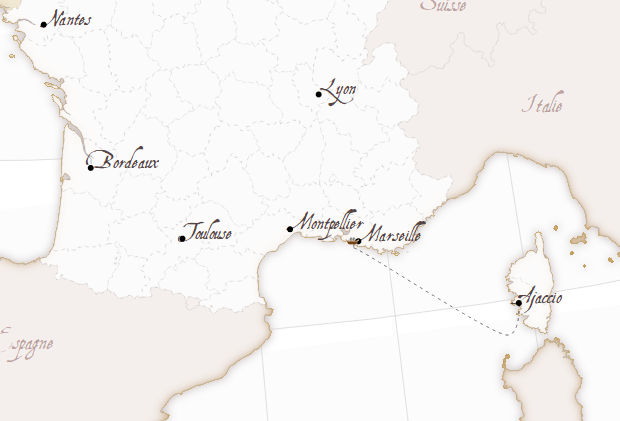This is the first post of a series to explain how to draw styled maps with paths in them, using D3js.
The final map will be an animated map of the Haiyan typhoon track:
This entries are to explain my last post La Belle France, which had a part with filters and an other with paths, not very clearly explained.
So first, the typhoon path data is needed, and a base map to draw under it too.
The final map will be an animated map of the Haiyan typhoon track:
This entries are to explain my last post La Belle France, which had a part with filters and an other with paths, not very clearly explained.
So first, the typhoon path data is needed, and a base map to draw under it too.
Base Map
To draw the maps for this tutorial, the wolrd map at 50m resolution used in most of the mbostock's examples will be used. The base map, is taken from this example, and can be seen, as usual, at bl.ocks.org.
The basic difference from the Mercator example is the projection variable:
var projection = d3.geo.mercator()
.scale(5*(width + 1) / 2 / Math.PI)
.translate([width / 2, height / 2])
.rotate([-125, -15, 0])
.precision(.1);
- The scale is multoplied by five, to zoom to the typhoon zone
- A rotation is added, to center the map to the typhoon zone
Typhoon Haiyan track
It's not easy to find the actual data for the hurricanes and typhoons in a convenient format. After looking into several sites, the one I like the most is this one from Japan. The data is in a list which is possible to copy, but putting all the points into an array is not an amusing activity. So here is the script I've used to transform the data into a json:
f = open("track.txt","r")
out = "["
for line in f:
day = int(line[12:16])
hour = int(line[16:18])
lat = float(line[20:24])
lon = float(line[28:34])
h_class = int(line[48:49])
out += '{"day":%d, "hour":%d, "lat":%.1f, "lon":%.1f, "class": %d},' %(
day, hour, lat, lon, h_class)
out = out[0:-1] + "]"
f.close()
print out
Where track.txt is the file where I pasted the data copied from the web page.
Links
The base map for the next posts
La Belle France - The blog entry that made me write this post
D3 Mercator world map example
Haiyan typhoon track data, from the Japan Meteorological Agency Best Track Data
Digital Typhoon in English, with tracks from many cuurent and past typhoons
Hong Kong observatory Haiyan typhoon track data
La Belle France - The blog entry that made me write this post
D3 Mercator world map example
Haiyan typhoon track data, from the Japan Meteorological Agency Best Track Data
Digital Typhoon in English, with tracks from many cuurent and past typhoons
Hong Kong observatory Haiyan typhoon track data

